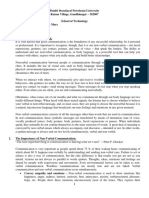Act#4 Eng.
Act#4 Eng.
Uploaded by
duh.die02Copyright:
Available Formats
Act#4 Eng.
Act#4 Eng.
Uploaded by
duh.die02Original Title
Copyright
Available Formats
Share this document
Did you find this document useful?
Is this content inappropriate?
Copyright:
Available Formats
Act#4 Eng.
Act#4 Eng.
Uploaded by
duh.die02Copyright:
Available Formats
1.
Nonverbal communication refers to the transmission of information or messages through means
other than spoken or written words. It includes gestures, facial expressions, body language, eye
contact, posture, tone of voice, and other forms of expression that convey meaning without
relying on verbal language. Nonverbal communication plays a crucial role in interpersonal
interactions, as it can often convey emotions, attitudes, intentions, and social cues more
accurately than words alone.
2. Nonverbal communication can significantly impact the way people interact and communicate
with each other. Here are a few ways in which it can affect communication:
Expressing emotions: Nonverbal cues such as facial expressions, gestures, and tone of voice can
convey emotions more accurately than words. They can enhance or contradict the verbal
message, influencing how the message is perceived.
Establishing trust: Nonverbal signals like eye contact, a warm smile, and open body language can
help build trust and rapport between individuals. Conversely, a lack of eye contact, crossed arms,
or tense body language can create barriers to effective communication.
Enhancing understanding: Nonverbal cues can complement and reinforce verbal messages,
helping to clarify meaning and avoid misunderstandings. For example, pointing while giving
directions, or nodding to indicate agreement.
Conveying attitudes and intentions: Nonverbal communication can reveal underlying attitudes,
intentions, and motivations. It can signal interest, disinterest, confidence, nervousness, or deceit,
which can greatly impact the overall communication process.
Cultural differences: Nonverbal communication can vary across different cultures and societies.
Gestures, facial expressions, and even personal space can have different meanings, so being
aware of cultural nuances is important to avoid potential misunderstandings.
Overall, nonverbal communication plays a vital role in shaping interpersonal dynamics,
establishing connections, and interpreting messages beyond just the spoken words. It adds
depth and richness to communication, making it a crucial aspect of human interaction.
3. Verbal communication and nonverbal communication are both essential forms of
communication, but they differ in several ways:
1. Nature: Verbal communication involves the use of words, spoken or written, to transmit
messages. It relies on language, grammar, and vocabulary to convey meaning. Nonverbal
communication, on the other hand, encompasses body language, facial expressions, gestures,
touch, and other non-linguistic cues.
2. Reliability: Verbal communication is often considered more explicit and direct, as words can
convey precise information and specific meanings. Nonverbal communication, however, is often
subconscious and can be open to interpretation. While verbal communication can be clearly
understood, nonverbal cues may be subjective and dependent on personal experiences and
cultural contexts.
3. Speed: Verbal communication tends to be faster than nonverbal communication, as it allows
for immediate expression and comprehension of ideas. Nonverbal cues, such as body language,
may take longer to interpret and process.
4. Control: Verbal communication provides more control over the message being conveyed. The
speaker can choose their words carefully and structure sentences to convey specific information.
In contrast, nonverbal communication is often spontaneous and difficult to control consciously.
It may reveal emotions or attitudes that the sender did not intend to communicate.
5. Complementarity: Verbal and nonverbal communication are highly interdependent and often
work together to convey messages effectively. They can reinforce, contradict, or enhance each
other. For example, a person's words may indicate agreement, but their nonverbal cues, such as
crossed arms, may suggest disagreement.
6. Cultural variations: Verbal communication varies significantly across different languages and
cultures. Nonverbal communication also exhibits cultural differences, with gestures, facial
expressions, and personal space having unique meaning and interpretations in various societies.
It's important to consider both verbal and nonverbal communication when engaging in any form
of interaction, as they both contribute to overall understanding and convey important aspects of
human communication.
4. Understand body language.Much of communication is nonverbal. Pay attention; it can be very
important. Maintain eye contact and notice any changes in your eye contact or the other
person's eye contact. Notice a person's posture and facial expressions and see if there are any
inconsistencies
You might also like
- Compass Level 5 Language LogDocument18 pagesCompass Level 5 Language LogDoaaNo ratings yet
- Types of Non-Verbal CommunicationDocument15 pagesTypes of Non-Verbal Communicationsomeguy64100% (1)
- The Importance of Non Verbal ComunicationDocument8 pagesThe Importance of Non Verbal ComunicationLeonardo UrraNo ratings yet
- Non Verbal CommunicationDocument13 pagesNon Verbal CommunicationSukoon SarangNo ratings yet
- Mega Flash PDFDocument1 pageMega Flash PDFangel.leurisNo ratings yet
- Non Verbal CommunicationDocument4 pagesNon Verbal Communication9v79mb29c2No ratings yet
- PC Imp TopicsDocument20 pagesPC Imp TopicsPrakhar BhawsarNo ratings yet
- Cs 40Document12 pagesCs 40debansh599No ratings yet
- 2301 Final Exam Q&A 2023Document33 pages2301 Final Exam Q&A 2023dietubrowNo ratings yet
- Cs 40Document12 pagesCs 40debansh599No ratings yet
- 1694757651662-Obba 0006S1M1RM20Document4 pages1694757651662-Obba 0006S1M1RM20Shubham SinghNo ratings yet
- Non-Verbal Communication 2Document7 pagesNon-Verbal Communication 2ThankGod UcheNo ratings yet
- 3460bd40-d3e1-453d-a073-73019d058768Document5 pages3460bd40-d3e1-453d-a073-73019d058768Roopa TadurNo ratings yet
- Unit 2 - 3 Types of Communcation & Effective Com SkillsDocument23 pagesUnit 2 - 3 Types of Communcation & Effective Com Skillsmajomemindy4No ratings yet
- Major Lab ProjectDocument14 pagesMajor Lab Projectarmanmund27No ratings yet
- Lecture TwoDocument10 pagesLecture Twostephanie halimaNo ratings yet
- Essayyyy EnglishDocument1 pageEssayyyy EnglishOmarieNo ratings yet
- English LLB AssignmentDocument11 pagesEnglish LLB Assignmentgaurishukla621No ratings yet
- Introduction To Non Verbal CommunicationDocument5 pagesIntroduction To Non Verbal Communicationmarcamiel.moralesNo ratings yet
- Week 3Document2 pagesWeek 3Jasper PaclibarNo ratings yet
- ProjectDocument21 pagesProjectNiko BellicNo ratings yet
- Note 2024-02-29 00-24-16Document26 pagesNote 2024-02-29 00-24-16mohammadiadel188No ratings yet
- Verbal and Nonverbal & CommunicationDocument14 pagesVerbal and Nonverbal & CommunicationYouusseeffNo ratings yet
- Forms of Communication Topic 4Document9 pagesForms of Communication Topic 4picegis725No ratings yet
- Note 2024-02-29 00-24-16Document22 pagesNote 2024-02-29 00-24-16mohammadiadel188No ratings yet
- Non-Verbal Ab - Rahim TelecomDocument3 pagesNon-Verbal Ab - Rahim Telecomukacc556677No ratings yet
- (DAPO) ICS 101 Lecture Note MRS Ajiboye - 2Document10 pages(DAPO) ICS 101 Lecture Note MRS Ajiboye - 2Ishola FatimahNo ratings yet
- Unit 1notesDocument13 pagesUnit 1notesdishamanchanda0077No ratings yet
- Chapter 6 Communication StyleDocument4 pagesChapter 6 Communication Stylegenevievegelinas7No ratings yet
- Communication SkillsDocument119 pagesCommunication SkillsGoats Randy100% (5)
- Comm. Processes, Principles, and EthicsDocument11 pagesComm. Processes, Principles, and EthicsPearl MapeNo ratings yet
- Activity 04Document2 pagesActivity 04zicobueno4No ratings yet
- Vi. Lesson 4 - Non Verbal CommunicationDocument5 pagesVi. Lesson 4 - Non Verbal CommunicationJessica Cabildo CalbanNo ratings yet
- Non-Verbal CommunicationDocument7 pagesNon-Verbal CommunicationSiddh Bhatt100% (2)
- Verbal and Non Verbal ParagraphDocument1 pageVerbal and Non Verbal Paragraphvjnprasana4555No ratings yet
- Good AfternoonDocument37 pagesGood AfternoonLASSER KATE VILLANUEVANo ratings yet
- Communication SkillsDocument4 pagesCommunication SkillsAsim DawarNo ratings yet
- CommunicationDocument11 pagesCommunication1102-bseics-s23No ratings yet
- Business CommunicationDocument8 pagesBusiness CommunicationVictor Batu DanboyiNo ratings yet
- CT1 Preparation NotesDocument23 pagesCT1 Preparation NotesMadhav SinhaNo ratings yet
- Nonverbal CommunicationDocument7 pagesNonverbal CommunicationShashank Nimesh100% (1)
- Communicating With Words As Well As With Body Language: NameDocument23 pagesCommunicating With Words As Well As With Body Language: NameAZZINo ratings yet
- Interpersonal Speech ContextDocument23 pagesInterpersonal Speech Contextlykapuno3No ratings yet
- Definitions of Nonverbal CommunicationDocument3 pagesDefinitions of Nonverbal CommunicationBloodless Khan100% (1)
- Verbal and Non - VerbalDocument9 pagesVerbal and Non - VerbalBenedict Lizardo MaddaraNo ratings yet
- Using Various Strategies Avoid Communication BreakdownDocument24 pagesUsing Various Strategies Avoid Communication BreakdownMYRRH TRAINNo ratings yet
- Non-Verbal Communication: DiscussionDocument10 pagesNon-Verbal Communication: DiscussionChriscell Gipanao EustaquioNo ratings yet
- Module 4Document9 pagesModule 4Earl CruzNo ratings yet
- AsivDocument15 pagesAsivJeremeil MencianoNo ratings yet
- Chapter 7 - Teaching NotesDocument13 pagesChapter 7 - Teaching NotesKanhchany SiphaNo ratings yet
- 2Document4 pages2serjorahhhNo ratings yet
- Effective Verbal and Nonverbal CommunicationDocument21 pagesEffective Verbal and Nonverbal CommunicationKin-Aleth Damiles AragonNo ratings yet
- Verbal and Non Verbal CommunicationDocument2 pagesVerbal and Non Verbal CommunicationRose Fetz100% (3)
- Communication SkillsDocument81 pagesCommunication SkillsmichaelNo ratings yet
- Cs - AnsDocument11 pagesCs - AnsHIDDEN Life OF 【शैलेष】No ratings yet
- Verbal and Non VerbalDocument2 pagesVerbal and Non VerbalShaik Khalid 1234No ratings yet
- Week Six NotesDocument26 pagesWeek Six NotesSon NickNo ratings yet
- Prashanth Nair Non Verbal Communication and Interpersonal SkillsDocument10 pagesPrashanth Nair Non Verbal Communication and Interpersonal SkillsPrashanth NairNo ratings yet
- Connecting Through Verbal CommunicationDocument8 pagesConnecting Through Verbal Communicationjeffrey.n.vicenteNo ratings yet
- Verbal and Non-Verbal Communication Handout RevisedDocument8 pagesVerbal and Non-Verbal Communication Handout RevisedDanier HolnessNo ratings yet
- Mindful Mind Reading: Techniques for Enhancing Empathy and UnderstandingFrom EverandMindful Mind Reading: Techniques for Enhancing Empathy and UnderstandingNo ratings yet
- The Special Needs of State English Language Education Adrian HollidayDocument9 pagesThe Special Needs of State English Language Education Adrian HollidaypanparasNo ratings yet
- Teaching Grammar: A Task-Based ApproachDocument28 pagesTeaching Grammar: A Task-Based Approachtoumache100% (1)
- Second Unknown Language LessonDocument2 pagesSecond Unknown Language LessonThales NicolettiNo ratings yet
- Basic Bootcamp S1 #4 Counting From 1-100 in Polish: Lesson NotesDocument5 pagesBasic Bootcamp S1 #4 Counting From 1-100 in Polish: Lesson NotesMargarida GawlikNo ratings yet
- Na Anglais SC HumainesDocument2 pagesNa Anglais SC HumainesSaid RamziNo ratings yet
- DemoDocument12 pagesDemoEdz SoretsellaBNo ratings yet
- The Business Advanced SBDocument160 pagesThe Business Advanced SBOctavioGarcia100% (1)
- Task PainDocument28 pagesTask PainMuhammad KaiNo ratings yet
- Test On Units 1-4 Prep 3Document2 pagesTest On Units 1-4 Prep 3joutubyeNo ratings yet
- Phonic Based InstructionDocument21 pagesPhonic Based InstructionDeshaniNo ratings yet
- Mixed Conditional PatternsDocument2 pagesMixed Conditional PatternsImelda Nayely GMNo ratings yet
- Literature Review of Grammatical MistakesDocument7 pagesLiterature Review of Grammatical Mistakesafmzsbzbczhtbd100% (1)
- GenEd English SlidesDocument241 pagesGenEd English Slidesmichelle gomezNo ratings yet
- The Ten Tone Groups - SummaryDocument1 pageThe Ten Tone Groups - SummaryVanina Guarnieri100% (1)
- All About Words - An Adult Approach To Vocabulary Building (1968, New American Library)Document420 pagesAll About Words - An Adult Approach To Vocabulary Building (1968, New American Library)Mohammad Shaiful Islam100% (1)
- Dai 1 Ka - Let's Learn Japanese Language EasilyDocument2 pagesDai 1 Ka - Let's Learn Japanese Language EasilyHendraNo ratings yet
- Irregular Verbs PPDocument1 pageIrregular Verbs PPKely S. AquinoNo ratings yet
- Grammatical Units Question-2075Document3 pagesGrammatical Units Question-2075Study EverydayNo ratings yet
- Resuelto Quiz 2 and Practice-English 1Document3 pagesResuelto Quiz 2 and Practice-English 1Wen Samayoa MoraNo ratings yet
- Exposition - Text - Concept, Structure, FeatureDocument3 pagesExposition - Text - Concept, Structure, FeatureFibri Adelia RahmawatiNo ratings yet
- Gabriel Jurado Foundation School, IncDocument22 pagesGabriel Jurado Foundation School, IncKen KanekiNo ratings yet
- Caiet Exercitii EnglezaDocument76 pagesCaiet Exercitii Englezamihaelaradu90No ratings yet
- J3 Revised Mid Year Exam Syllabus 2024Document1 pageJ3 Revised Mid Year Exam Syllabus 2024nuclearbomb9000No ratings yet
- Adjectives AdverbsDocument20 pagesAdjectives AdverbsCeciliaChiMeiChanNo ratings yet
- SemanticsDocument19 pagesSemanticsLina KurniawatiNo ratings yet
- Ese Nigerian Meaning - Google SearchDocument1 pageEse Nigerian Meaning - Google SearchEse VerereNo ratings yet
- Vocabulary Lesson Classroom IdeasDocument4 pagesVocabulary Lesson Classroom IdeasRafael AngelNo ratings yet
- Det6: Possessive DeterminersDocument3 pagesDet6: Possessive DeterminersGiudi RosatoNo ratings yet

























































































